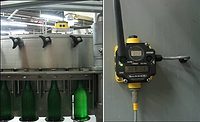Sensing technology
Wireless sensors help prevent critical line stoppages
Wireless sensors mount on a motor and send data to the cloud or plant network for analytics

It is estimated that electric motors account for 45 per cent of global electricity demand. That’s not surprising when you consider that they’re used to drive everything from pumps and fans to compressors in industries as varied as industrial, commercial, agricultural and transport.
The problem is that increasingly complex food and beverage segments place a demand on motors to run continuously for long periods of time. This can lead to premature failure of the motor if it is not monitored closely.
In situations like this, carrying out traditional motor condition monitoring is an expensive and time consuming process. For most businesses that use low voltage motors, it’s often cheaper to simply run the motor until it fails and then replace it with another one. The consequence is that plants face unexpected downtime, lost production and possible secondary damage to other equipment. This approach can lead to spoilage of perishable food and drink items when the motor fails, forcing factory staff to spend precious time cleaning and preparing equipment to return it to operation.
Simone Wendler, food and beverage segment manager for ABB’s motors and generators business, says the company has an approach to monitoring important motors in a plant where it’s not practical or possible to run wires. Unless you’re buying and installing new motors with sensing technology built in, retrofitting older motors is not necessarily an easy proposition.
The rise of the Industrial Internet of Things (IIoT) combined with a greater focus on energy efficiency, means that businesses no longer need to run motors until they fail. Instead, new technology opens up opportunities to make drastic improvement to operations. With IIoT devices, processors can make use of better big-data analytics and machine-to-machine (M2M) communication to improve energy efficiency and diagnose faults ahead of time. IIoT devices enable enhanced condition monitoring, allowing maintenance engineers to remotely monitor and collect operational trend data to minimize unexpected downtime.
Although this is great for future smart factories, it’s not feasible for plant managers to replace an entire fleet of analog motors today. Although modern, three-phase induction motors are much more efficient, smaller and lighter than motors from 120 years ago, the basic concept has not changed much. This creates a barrier for manufacturers that want to adopt smart technology but simply don’t have the resources to overhaul entire systems.
To address this problem, ABB has developed the ABB Ability Smart Sensor for low voltage motors. The smart sensor can be retrofitted to many types of existing low voltage motors in minutes. It attaches to the motor frame without wires and uses Bluetooth Low Energy to communicate operational data to a smartphone app, desktop PC or even in encrypted form to the cloud for advanced analytics.
The sensor collects data, including various types of vibration, bearing health, cooling efficiency, air-gap eccentricity, rotor winding health, skin temperature, energy consumption, loading, operating hours, number of starts and speed in rpm.
The result is that the motor lets the operator know when it’s time for a service. Advanced analytics from the cloud can also provide advice on the status and health of the entire fleet. Data collected by ABB shows that the smart sensor can help users reduce motor downtime by up to 70 per cent, extend the lifetime by as much as 30 per cent and lower energy use by up to 10 per cent, a clear indicator that predictive, rather than reactive, maintenance increases reliability.
The applications for wireless sensors
FE asked Jonas Spoorendonk — global product manager, ABB Ability Smart Sensor, a couple of questions on the application of the sensor.
FE: For what size motor (hp) is this IIoT-based sensor solution practical and cost-effective?
Spoorendonk: I understand this question as asking for a lower limit, asking if it is cost-effective to monitor small motors. With small motors I find that it is not so much size, but rather labor cost that defines what is cost-effective, and a few hours of labor will often cost more than the motor and sensor.
Generally speaking, if it is a nuisance to access the motor for a standard inspection then it is cost-effective. For example, we find a lot of motors in food plants that are partly covered by shrouds and, therefore, difficult to inspect.
Especially in the food industry, it is also very interesting to be able to document the flawless operation of equipment, which is possible with the smart sensor, and is another benefit that is size-independent.
Nevertheless, most of our customers start with monitoring of motors from 15 hp and upwards before they look at smaller [motors].
FE: If several motors are relatively close together in a plant, can these sensors be networked (Wi-Fi) together in a mesh network to extend range?
Spoorendonk: Motors and sensors that are close together will benefit from using the same Bluetooth router for automatic data collection, and our router has a very good range and a good capability for going around corners.
A mesh network between smart sensors is not feasible because the energy consumption is too high for the benefits we get. We have chosen not to use mesh networking, and instead use the available energy for other purposes, mainly more data and a longer battery life. In a mesh every sensor must be ready at all times to receive a data package from a neighbor and pass it on to the next neighbor, and this requires energy. But the energy cost of meshing is going down, protocols continue to develop and there are a lot of interesting start-ups in this field, so we follow the topic closely.
For more information, visit the ABB Food & Beverage web site.
Looking for a reprint of this article?
From high-res PDFs to custom plaques, order your copy today!






